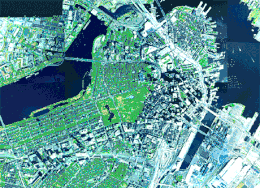
Satellite image of Boston showing urban tree canopy variations
Urban forest inequity, sometimes called shade inequity or tree canopy inequity,[1] is the inequitable distribution of trees, with their associated benefits, across metropolitan areas.[2] Urban forest inequity has a number of follow-on effects, including measurable impacts on faunal biodiversity,[3] and urban heat inequity, in which intraurban heat islands, with their associated negative health consequences, are more common and more intense in lower-income communities.[4][5]
See also
References
- ↑ Wolfsdorf, Isabella (2022-01-01). "Shade Equity in Louisville, KY: Considering Environmental Justice in an Analysis of Urban Tree Canopy Inequality and Demographics". Environmental Studies Electronic Thesis Collection.
- ↑ Aznarez, Celina; Svenning, Jens-Christian; Pacheco, Juan Pablo; Have Kallesøe, Frederik; Baró, Francesc; Pascual, Unai (2023-08-16). "Luxury and legacy effects on urban biodiversity, vegetation cover and ecosystem services". npj Urban Sustainability. 3 (1): 1–11. doi:10.1038/s42949-023-00128-7. ISSN 2661-8001.
- ↑ Wood, Eric M.; Esaian, Sevan (2020). "The importance of street trees to urban avifauna". Ecological Applications. 30 (7): 1–20. doi:10.2307/27029104. ISSN 1051-0761.
- ↑ "Heat Islands and Equity". epa.gov.
- ↑ "The Inequitable Distribution of Urban Trees". earthobservatory.nasa.gov. 2022-09-19. Retrieved 2023-10-28.
External links
- Leahy, Ian; Serkez, Yaryna (2021-06-30). "Since When Have Trees Existed Only for Rich Americans?". Opinion. The New York Times. ISSN 0362-4331. Retrieved 2023-10-28.
This article is issued from Wikipedia. The text is licensed under Creative Commons - Attribution - Sharealike. Additional terms may apply for the media files.